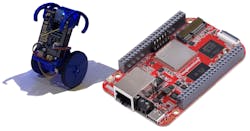Check out Electronic Design's coverage of CES 2024. This video is also part of the TechXchange: RISC-V: The Instruction-Set Alternative.
What you’ll learn:
- What RISC-V capabilities are provided by the BeagleV-Fire?
- What’s inside a PolarFire SoC FPGA?
I was able to talk with Jason Kridner, founder of BeagleBoard.org, about the organization's latest BeagleV-Fire platform (Fig. 1). The video (above) shows the board controlling a balancing robot.
The BeagleBoard family of modules is built around a dual 46-pin BeagleBone cape header. The BeagleV-Fire is the latest platform. In the demo, a BeagleBone cape with interfaces is used for motor control to handle the wheel motors. The balancing act is trivial with minimal load on the FPGA or RISC-V cores, but it’s visual. The possibilities with an FPGA SoC are very interesting, though.
BeagleV-Fire is built around a Microchip PolarFire MPFS025T FPGA SoC (Fig. 2). This includes a five-core RISC-V system—a 64-bit, SiFive E51 RV64IMAC control processor and four 64-bit, RV64GC SiFive U54-MC cores. The latter includes virtual memory support capable of running operating systems like Linux.
The FPGA incorporates 23K logic elements, 68 math blocks (18 × 18 MACC), and four 12.7-Gb/s SERDES. A SYZYGY connector on the board is targeted at high-speed FPGA connections. The SoC also has 128 kB of eNVM and 65 kB of sNVM.
The module includes 2 GB of LPDDR4 memory, too. Non-volatile storage comes in a 16-GB eMMC chip and 128-Mb SPI flash (Fig. 3). Furthermore, there’s a microSD socket and an M.2 E-Key socket, although that tends to be used for a wireless adapter such as Wi-Fi/Bluetooth. It supports PCIe and SDIO interfaces. Also in the mix is a single, 22-pin CSI camera connector. Gigabit Ethernet is built-in and the USB Type-C operates at 480 Mb/s. And there’s a 6-pin, 3.3-V UART connection plus JTAG support.
In case you want to work with RISC-V but don’t care to have an FPGA on-chip, then the BeagleV-Ahead might be a better bet (Fig. 4). This board is built around an Alibab T-Head TH1520 SoC with a 2-GHz, quad-core, 64GX Xuantie C910 processor with a 4 TOPS@INT8 network processing unit (NPU). It also offers a 50-GFLOPS, 3-Mpixel/s Imagination GXM-4-64 GPU.
This board includes 4 GB of LPDDR4 as well as a 16-GB eMMC flash memory. Memory expansion is via a microSD socket. The system supports Ethernet, dual-band Wi-Fi, and Bluetooth. Other features are a micro-HDMI output, a mikroBUS connection, two CSI camera interfaces, and a DSI connector.
The BeagleBoard family is a popular alternative to Arduino and Raspberry Pi. Microchip’s Libero SoC Design Suite provides FPGA programming support. The RISC-V processors can run BeagleBoard Linux, which comes preinstalled.
Unboxing of the BeagleV-Fire board.
Check out more of Electronic Design's coverage of CES 2024. Also check out more videos/articles in the TechXchange: RISC-V: The Instruction-Set Alternative.



